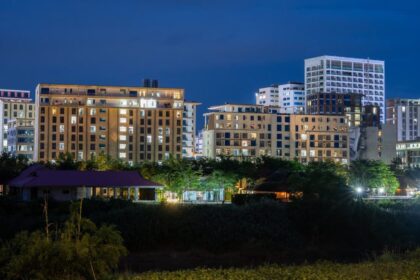Understanding Air Conditioning Sickness in the Monsoon Season
As the monsoon season brings relief from scorching summer heat, it also ushers in high humidity and fluctuating temperatures. In many parts of Asia, including South Korea and India, this leads to a surge in air conditioner use. While air conditioning provides comfort, health experts are increasingly warning about “air conditioning sickness”—a cluster of symptoms and health risks that become especially pronounced during the rainy season. This article explores the causes, symptoms, and preventive measures for air conditioning sickness, drawing on expert insights and scientific research.
- Understanding Air Conditioning Sickness in the Monsoon Season
- What Is Air Conditioning Sickness?
- Why Does the Monsoon Season Increase the Risks?
- Common Symptoms and Health Effects
- The Role of Air Conditioner Maintenance
- How Sudden Temperature Changes Affect the Body
- Monsoon-Related Respiratory Risks
- Other Health Risks Associated with Air Conditioning
- Environmental and Social Implications
- Practical Tips to Prevent Air Conditioning Sickness
- Special Considerations for Vulnerable Groups
- Debunking Myths: Does Rain Make You Sick?
- Broader Monsoon Health Risks
- Alternative Cooling Solutions
- In Summary
What Is Air Conditioning Sickness?
Air conditioning sickness refers to a range of health issues that arise from prolonged exposure to air-conditioned environments, particularly when there is a significant temperature difference between the cool indoors and the hot, humid outdoors. The condition is not a single disease but a collection of symptoms triggered by factors such as sudden temperature changes, low indoor humidity, and poor air quality due to inadequate maintenance of AC units.
During the monsoon, these risks are amplified. The combination of high outdoor humidity and the tendency to keep windows closed for long periods can create an environment where air conditioners work harder, accumulate moisture, and potentially harbor harmful microorganisms.
Why Does the Monsoon Season Increase the Risks?
The monsoon season is characterized by heavy rainfall, high humidity, and fluctuating temperatures. These conditions not only make people more reliant on air conditioning but also create ideal circumstances for the growth of mold, bacteria, and other allergens inside AC units. According to Dr. Viswesvaran B, a pulmonology expert, increased humidity and stagnant water during the monsoon promote the proliferation of mold and dust mites, both of which can worsen respiratory health.
Moreover, the habit of keeping windows closed to keep out rain and humidity reduces ventilation, leading to poor indoor air quality. This trapped air often contains higher concentrations of allergens and pollutants, which can irritate the respiratory system and exacerbate existing health conditions.
Common Symptoms and Health Effects
Air conditioning sickness can manifest in various ways, depending on individual susceptibility and the quality of indoor air. Some of the most frequently reported symptoms include:
- Respiratory Issues: Coughing, sneezing, sore throat, nasal congestion, and exacerbation of asthma or allergies.
- Headaches and Fatigue: Sudden temperature changes can cause blood vessels to constrict and expand, leading to headaches and a feeling of lethargy.
- Dryness: Dry eyes, dry or itchy skin, and dehydration due to reduced indoor humidity.
- Muscle Cramps and Stiffness: Especially in women, exposure to cold air can worsen menstrual cramps and cause muscle stiffness.
- Flu-like Symptoms: Chills, body aches, and general malaise, often mistaken for viral infections.
- Allergic Reactions: Exposure to dust, mold, and other allergens circulating through poorly maintained AC systems can trigger allergic symptoms.
Expert Insights on Gender Differences
Women are particularly susceptible to certain symptoms of air conditioning sickness. Health experts in South Korea have noted that cold air exposure can exacerbate menstrual cramps and increase discomfort during the monsoon. Additionally, women are more prone to dry eye syndrome, which can be aggravated by prolonged exposure to air-conditioned environments.
The Role of Air Conditioner Maintenance
One of the most significant contributors to air conditioning sickness is poor maintenance of AC units. Filters and ducts can accumulate dust, mold, and bacteria, which are then circulated throughout the indoor environment. Legionella bacteria, for example, can thrive in moist, unclean AC systems and cause Legionnaires’ disease—a severe form of pneumonia.
Mold and Bacterial Growth
Moisture from humid air tends to accumulate inside AC filters and ducts, especially during the monsoon. If these parts are not cleaned regularly, mold and mildew can develop, causing musty odors and potentially triggering respiratory problems. According to Michael Golubev, CEO of Mold Busters, mold growth is especially common in humid climates or during rainy seasons. Inhaling mold spores can lead to congestion, inflammation, and other respiratory symptoms.
Indoor Air Quality and Allergens
Even with filters in place, air conditioners can circulate microscopic allergens such as dust, pollen, and pet dander. These particles can worsen allergies and sinus problems, leading to headaches, sore throats, and persistent coughs. Dr. Sara Chen Xie, an otolaryngologist, notes that even a small amount of dust can trigger uncomfortable sinus symptoms.
How Sudden Temperature Changes Affect the Body
Moving between a cool, air-conditioned room and the hot, humid outdoors can disrupt the body’s autonomic nervous system. This system regulates involuntary functions such as heart rate, blood pressure, and body temperature. Sudden shifts can cause blood pressure fluctuations, reduced blood flow to the brain, and a general feeling of discomfort or malaise.
Dr. Vineet Arora, Director of Internal Medicine at Max Super Speciality Hospital, explains that while air conditioning itself does not directly cause illness, the inability to regulate temperature while asleep or during prolonged exposure can contribute to feeling unwell. Overcooling, in particular, can make the body more susceptible to respiratory infections and muscle stiffness.
Monsoon-Related Respiratory Risks
The monsoon season is notorious for a spike in respiratory illnesses. High humidity and damp conditions promote the growth of mold and mildew, which release spores into the air. These spores can exacerbate asthma, bronchitis, and other respiratory allergies. Additionally, the increased moisture can lead to the proliferation of dust mites, further aggravating respiratory issues.
Dr. Viswesvaran B emphasizes the importance of maintaining cleanliness, using dehumidifiers, and ensuring proper ventilation to reduce the risk of respiratory diseases during the monsoon.
Other Health Risks Associated with Air Conditioning
- Dehydration: Air conditioning reduces humidity, which can lead to increased water loss from the body through respiration and perspiration. This can cause dry skin, headaches, and dizziness if not compensated by adequate fluid intake.
- Noise Pollution: The constant humming of AC units can disrupt sleep patterns and increase stress levels, especially during nighttime.
- Indoor Pollutants: Closed environments with recirculated air can accumulate volatile organic compounds (VOCs), dust, and other pollutants, contributing to poor indoor air quality.
- Infectious Diseases: Poorly maintained AC systems can harbor bacteria, viruses, and fungi, increasing the risk of respiratory infections.
Environmental and Social Implications
While air conditioning is essential for comfort and protection against heat-related illnesses, its widespread use has broader implications. Increased energy consumption contributes to greenhouse gas emissions and urban heat islands. Overreliance on AC can also strain power grids, especially during peak demand in the monsoon season.
Experts from the Kleinman Center for Energy Policy advocate for alternative cooling solutions, such as passive building design, improved ventilation, and the use of air coolers that maintain natural humidity levels. These approaches can reduce both environmental impact and health risks associated with traditional air conditioning.
Practical Tips to Prevent Air Conditioning Sickness
- Regular Maintenance: Clean or replace AC filters every one to three months. Inspect for mold, dust, and bacterial buildup, and clean ducts and drain pans regularly.
- Moderate Temperature Settings: Set the thermostat between 24°C and 26°C (75°F to 79°F) to avoid overcooling. Avoid setting the temperature too low, especially at night.
- Control Humidity: Use the “Dry Mode” on your AC to reduce excess moisture without excessive cooling. Consider using a humidifier if indoor air becomes too dry.
- Ensure Proper Ventilation: Open windows periodically to allow fresh air circulation. Use exhaust fans and air purifiers with HEPA filters to remove airborne allergens and pollutants.
- Stay Hydrated: Drink plenty of water to compensate for moisture loss due to dry indoor air.
- Protect Against Allergens: Use high-efficiency filters and keep indoor spaces clean to minimize dust, mold, and pet dander.
- Monitor Health: Pay attention to symptoms such as persistent cough, headaches, or skin irritation. Seek medical advice if symptoms persist or worsen.
Special Considerations for Vulnerable Groups
Certain populations are more susceptible to the health risks associated with air conditioning during the monsoon:
- Children and the Elderly: More prone to dehydration, respiratory issues, and temperature-related discomfort.
- People with Chronic Illnesses: Those with asthma, allergies, or heart conditions should be especially cautious about indoor air quality and temperature regulation.
- Pregnant Women: May experience increased sensitivity to temperature changes and dehydration.
Debunking Myths: Does Rain Make You Sick?
It is a common misconception that getting wet in the rain directly causes illness. According to Health.com, rain itself does not transmit viruses. However, being cold and wet for prolonged periods can lower body temperature and weaken the immune system, indirectly increasing susceptibility to infections. The real risk during the monsoon comes from spending more time indoors in poorly ventilated spaces, which facilitates the spread of viruses and allergens.
Broader Monsoon Health Risks
Beyond air conditioning sickness, the monsoon season brings a host of other health challenges. Increased humidity, water stagnation, and poor sanitation create breeding grounds for infectious diseases such as dengue, malaria, typhoid, and hepatitis. Respiratory infections, skin problems, and gastrointestinal illnesses also become more common.
To stay safe, experts recommend:
- Drinking only boiled or filtered water
- Avoiding raw or semi-cooked foods
- Maintaining strict food hygiene
- Regular medical check-ups and prompt testing for persistent symptoms
Alternative Cooling Solutions
Given the health and environmental risks of overreliance on air conditioning, alternative cooling methods are gaining attention. Air coolers, for example, maintain more natural humidity levels and circulate fresh air, reducing the risk of dryness and indoor pollution. Passive cooling strategies, such as improved building insulation, shading, and natural ventilation, can also help maintain comfortable indoor temperatures without excessive energy use.
In Summary
- Air conditioning sickness is a real concern during the monsoon, with symptoms ranging from respiratory issues to headaches and dehydration.
- Poor maintenance of AC units can lead to mold, bacteria, and allergen buildup, increasing health risks.
- Sudden temperature changes between indoor and outdoor environments can disrupt the body’s natural regulation and exacerbate symptoms.
- Women, children, the elderly, and people with chronic illnesses are particularly vulnerable.
- Regular cleaning, moderate temperature settings, proper ventilation, and hydration are key preventive measures.
- Alternative cooling solutions and passive building design can reduce both health risks and environmental impact.
- Awareness and proactive care are essential to stay healthy and comfortable during the monsoon season.












